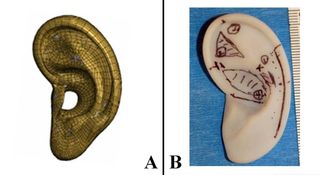
From artificial eyeballs to limbs, doctors have dreamed up dozens of ways to replace body parts when things go wrong.
Now they can add a new device to their repertoire: a lifelike, flexible ear made from cartilage cells seeded on a titanium scaffold.
The new technique, described July 30 in the Journal of the Royal Society Interface, is better than previous tissue-engineering efforts and could replace a laborious technique that requires plastic surgeons to fashion a crude ear shape out of a lump of cartilage. The procedure could be used in trauma injury patients who have lost an ear or in children with microtia, a congenital ear deformity, said bioengineer Tom Cervantes, who was at Massachusetts General Hospital at the time of the research.
Prosthetic ears
In the race to create bionic humans, ears have been a surprisingly tricky challenge. Numerous artificial ears are in medical use, but most had problems. Ears made from cartilage cells would often shrivel once implanted onto an animal. Prosthetic ears typically weren't very flexible or realistic-looking. And the reigning practice of extracting cartilage from a person's ribs and fashioning it into an ear was laborious and difficult to match with a person's other ear. Recently, researchers reported they had used a 3D printer to create a bioengineered ear. [The Top 5 Weirdest Prosthetics ]
"For something like the ear where it's very cosmetic in nature, having a proper shape is one of the most important requirements. We wouldn't want it to look like a shriveled nub," Cervantes, who is now at Stanford University School of Medicine in California, told LiveScience.
Cervantes and his colleagues wanted to create something that could be customized. The team started with a 3D computer model and used that to create a titanium mesh of the basic ear shape. They then seeded the mesh with cartilage cells that formed their own matrix over the mesh.
Sign up for the Live Science daily newsletter now
Get the world’s most fascinating discoveries delivered straight to your inbox.
To see how the ear would hold up when connected to a blood supply, the team implanted the ear on several rats' backs and studied them for several weeks. Unlike previous attempts, the ear didn't shrivel up nor become deformed.
Because the design is based on a 3D model, there's no reason that a person couldn't have a matching set of symmetrical earlobes based on their own shape, Cervantes said.
"The way we've gone about creating it paves the way for creating patient-specific ear shapes," Cervantes said.
Follow Tia Ghose on Twitterand Google+. Follow LiveScience @livescience, Facebook & Google+. Original article on LiveScience.com.

Tia is the managing editor and was previously a senior writer for Live Science. Her work has appeared in Scientific American, Wired.com and other outlets. She holds a master's degree in bioengineering from the University of Washington, a graduate certificate in science writing from UC Santa Cruz and a bachelor's degree in mechanical engineering from the University of Texas at Austin. Tia was part of a team at the Milwaukee Journal Sentinel that published the Empty Cradles series on preterm births, which won multiple awards, including the 2012 Casey Medal for Meritorious Journalism.
Most Popular



